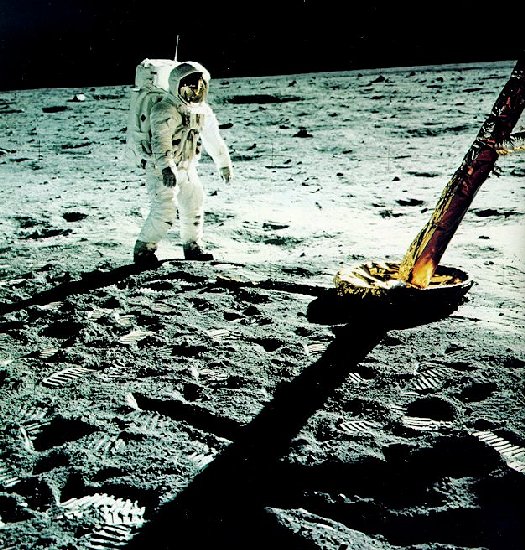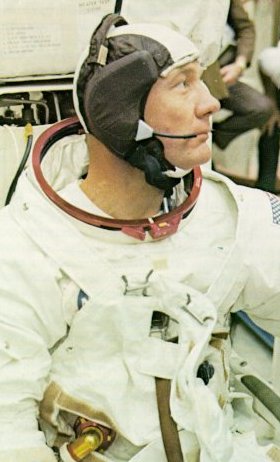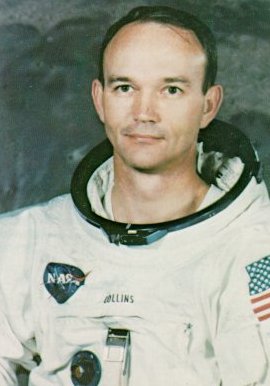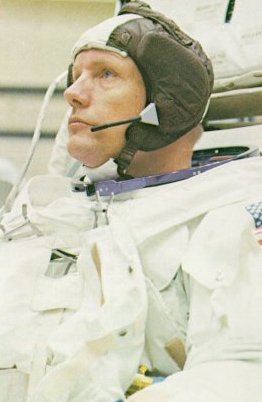
"The Eagle Has Landed"
By MICHAEL COLLINS and EDWIN E. ALDRIN, JR.

|
| The loneliness of space exploration is captured in this picture of Buzz Aldrin standing by Eagle's foil-wrapped footpad. (But a tiny image of Armstrong taking the photograph can be seen on his reflective faceplate.) The slightly arms-out stance derives from the pressurized suit. A plaque on the landing stage, which is still on the Moon, is engraved: "Here men from the planet Earth first set foot upon the Moon, July 1969, A.D. We came in peace for all mankind." |
|
Prelude
All was ready. Everything had been done. Projects Mercury and Gemini. Seven years of Project Apollo. The work of more than 300,000 Americans. Six previous unmanned and manned Apollo flights. Planning, testing, analyzing, training. The time had come. We had a great deal of confidence. We had confidence in our hardware: the Saturn rocket, the command module, and the lunar module. All flight segments had been flown on the earlier Apollo fights with the exception of the descent to and the accent from the Moon's surface and, of course, the exploration work on the surface. These portions were far from trivial, however, and we had concentrated our training on them. Months of simulation with our colleagues in the Mission Control Center had convinced us that they were ready. Although confident, we were certainly not overconfident. In research and in exploration, the unexpected is always expected. We were not overly concerned with our safety, but we would not be surprised if a malfunction or an unforeseen occurrence prevented a successful lunar landing. As we ascended in the elevator to the top of the Saturn on the morning of July 16, 1969, we knew that hundreds of thousands of Americans had given their best effort to give us this chance. Now it was time for us to give our best. |
The splashdown May 26, 1969, of Apollo 10 cleared the way for the first formal attempt at a manned lunar landing. Six days before, the Apollo 11 launch vehicle and spacecraft half crawled from the VAB and trundled at 0.9 mph to Pad 39-A. A successful countdown test ending on July 3 showed the readiness of machines, systems, and people. The next launch window (established by lighting conditions at the landing site on Mare Tranquillitatis) opened at 9:32 AM EDT on July 16, 1969. The crew for Apollo 11, all of whom had already flown in space during Gemini, had been intensively training as a team for many months. The following mission account makes use of crew members' own words, from books written by two of them, supplemented by space-to-ground and press-conference transcripts.
ALDRIN: At breakfast early on the morning of the launch. Dr. Thomas Paine, the Administrator of NASA, told us that concern for our own safety must govern all our actions, and if anything looked wrong we were to abort the mission. He then made a most surprising and unprecedented statement: if we were forced to abort, we would be immediately recycled and assigned to the next landing attempt. What he said and how he said it was very reassuring.
We were up early, ate, and began to suit up - a rather laborious and detailed procedure involving many people, which we would repeat once again, alone, before entering the LM for our lunar landing.
While Mike and Neil were going through the complicated business of being strapped in and connected to the spacecraft's life-support system, I waited near the elevator on the floor below. I waited alone for fifteen minutes in a sort of serene limbo. As far as I could see there were people and cars lining the beaches and highways. The surf was just beginning to rise out of an azure-blue ocean. I could see the massiveness of the Saturn V rocket below and the magnificent precision of Apollo above. I savored the wait and marked the minutes in my mind as something I would always want to remember.

| Edwin E. Aldrin, Jr., then an Air Force colonel, was the lunar module pilot for Apollo 11 . He had graduated third in his class at West Point, and earned a Ph.D. in astronautics at MIT. His prior space experience was as pilot for Gemini 12. |
COLLINS: I am everlastingly thankful that I have flown before, and that this period of waiting atop a rocket is nothing new. I am just as tense this time, but the tenseness comes mostly from an appreciation of the enormity of our undertaking rather than from the unfamiliarity of the situation. I am far from certain that we will be able to fly the mission as planned. I think we will escape with our skins, or at least I will escape with mine, but I wouldn't give better than even odds on a successful landing and return. There arc just too many things that can go wrong. Fred Haise [the backup astronaut who had checked command-module switch positions] has run through a checklist 417 steps long. and I have merely a half dozen minor chores to take care of - nickel and dime stuff. In between switch throws I have plenty of time to think, if not daydream. Here I am, a white male, age thirty-eight, height 5 feet 11 inches, weight 165 pounds, salary $17,000 per annum, resident of a Texas suburb, with black spot on my roses, state of mind unsettled, about to be shot off to the Moon. Yes, to the Moon.
At the moment, the most important control is over on Neil's side, just outboard of his left knee. It is the abort handle, and now it has power to it, so if Neil rotates it 30 counterclockwise, three solid rockets above us will fire and yank the CM free of the service module and everything below it. It is only to be used in extremes. A large bulky pocket has been added to Neil's left suit leg, and it looks as though if he moves his leg slightly, it's going to snag on the abort handle. I quickly point this out to Neil, and he grabs the pocket and pulls it as far over to the inside of his thigh as he can, but it still doesn't look secure to either one of us. Jesus, I can see the headlines now: "MOONSHOT FALLS INTO OCEAN." Mistake by crew, program officials intimate. Last transmission from Armstrong prior to leaving the pad reportedly was 'Oops.'"

| Michael Collins was the command module pilot, in orbit above the two others on the surface. A West Pointer and Air Force lieutenant colonel, he had flown in Gemini 10. These unsmiling photos were taken before the mission; but also see here. |
ARMSTRONG: The flight started promptly, and I think that was characteristic of all events of the flight. The Saturn gave us one magnificent ride, both in Earth orbit and on a trajectory to the Moon. Our memory of that differs little from the reports you have heard from the previous Saturn V flights.
ALDRIN: For the thousands of people watching along the beaches of Florida and the millions who watched on television, our lift-off was ear shattering. For us there was a slight increase in the amount of background noise, not at all unlike the sort one notices taking off in a commercial airliner, and in less than a minute we were traveling ahead of the speed of sound.
COLLINS: This beast is best felt. Shake, rattle, and roll! We are thrown left and right against our straps in spasmodic little jerks. It is steering like crazy, like a nervous lady driving a wide car down a narrow alley, and I just hope it knows where it's going, because for the first ten seconds we are perilously close to that umbilical tower.

| Neil Armstrong, commander of Apollo 11, a civilian, had flown in space in Gemini 8. An engineer and test pilot, he once flew the X-15 above 200,000 feet and at more than 4000 mph. |
ALDRIN: A busy eleven minutes later we were in Earth orbit. The Earth didn't look much different from the way it had during my first flight, and yet I kept looking at it. From space it has an almost benign quality. Intellectually one could realize there were wars underway, but emotionally it was impossible to understand such things. The thought reoccurred that wars are generally fought for territory or are disputes over borders; from space the arbitrary borders established on Earth cannot be seen. After one and a half orbits a preprogrammed sequence fired the Saturn to send us out of Earth orbit and on our way to the Moon.
ARMSTRONG: Hey Houston, Apollo 11. This Saturn gave us a magnificent ride. We have no complaints with any of the three stages on that ride. It was beautiful.
COLLINS: We started the burn at 100 miles altitude, and had reached only 180 at cutoff, but we are climbing like a dingbat. In nine hours, when we are scheduled to make our first midcourse correction, we will be 57,000 miles out. At the instant of shutdown, Buzz recorded our velocity as 35,579 feet per second, more than enough to escape from the Earth's gravitational field. As we proceed outbound, this number will get smaller and smaller until the tug of the Moon's gravity exceeds that of the Earth's and then we will start speeding up again. It's hard to believe that we are on our way to the Moon, at 1200 miles altitude now, less than three hours after liftoff, and I'll bet the launch-day crowd down at the Cape is still bumper to bumper, straggling back to the motels and bars.
ALDRIN: Mike's next major task, with Neil and me assisting, was to separate our command module Columbia from the Saturn third stage, turn around and connect with the lunar module Eagle, which was stored in the third stage. Eagle, by now, was exposed; its four enclosing panels had automatically come off and were drifting away. This of course was a critical maneuver in the flight plan. If the separation and docking did not work, we would return to Earth. There was also the possibility of an in-space collision and the subsequent decompression of our cabin, so we were still in our spacesuits as Mike separated us from the Saturn third stage. Critical as the maneuver is, I felt no apprehension about it, and if there was the slightest inkling of concern it disappeared quickly as the entire separation and docking proceeded perfectly to completion. The nose of Columbia was now connected to the top of the Eagle and heading for the Moon as we watched the Saturn third stage venting, a propulsive maneuver causing it to move slowly away from us.
Fourteen hours after liftoff, at 10:30 PM by Houston time, the three astronauts fasten covers over the windows of the slowly rotating command module and go to sleep. Days 2 and 3 are devoted to housekeeping chores, a small midcourse velocity correction, and TV transmissions back to Earth. In one news digest from Houston, the astronauts are amused to hear that Pravda has referred to Armstrong as "the czar of the ship".
ALDRIN: In our preliminary flight plan I wasn't scheduled to go to the LM until the next day in lunar orbit, but I had lobbied successfully to go earlier. My strongest argument was that I'd have ample time to make sure that the frail LM and its equipment had suffered no damage during the launch and long trip. By that time neither Neil nor I had been in the LM for about two weeks.
| Next |